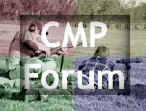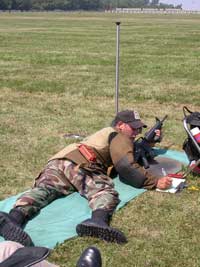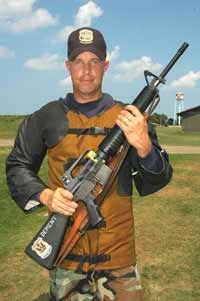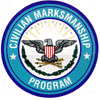

| We want your feedback! Please let us know what you think about TFS. Do you have an interesting story or article that you would like to share? If so, please let us know!
|
Reader Comments:
Thank you for this excellent e-newsletter. The links and information are great.
Sincerely,
John B.
I greatly enjoy the USAMU shooting tips in the newsletter and also being able to find them on-line.
Regards, Ray in FLA
EXCELLENT BRIEF UNDERSTANDABLE ARTICLE ON SITTING RAPID POSITION, BEING CLOSE TO 60 THIS IS MY WORST POSITION AND ANY HELP I CAN GET IS GREATLY APPRECIATED!
GOOD ARTICLE; MARTY
SFC Singley:
It has been a while, but I sent CMP a request for a TFS article on possible means by which us "centrally endowed" (read that as 'fat') shooters might work ourselves into a useable sitting position. Spring is coming and I will be trying to get ready for matches. Your article has been copied and I will read it and work on trying the options you have provided. Thanks very much for your individual military service to our Nation and for your personal efforts to help other shooters improve our skills.
Melvin C.
Really enjoyed the M1 for Vets article. Its really good to read something that was done for
wounded vets. The match must have been a real wingding. Too cold for me. There is alot of
history 1903 Springfield and the M1 . I had to sleep with my o3 for baning the butt on the
deck in boot camp. Anyway thanks again for the story.
Jim N., Ok
I enjoy the TFS. In fact, occasionally I like to print some of the articles to be able to review them in the future.
James L. M.
Whenever we come back in from the field it’s always a good day when “The First Shot” is in. I drill the guys in the fundamentals – many of which I learned and fine tuned at CMP matches – and it comes back in spades out here when it really counts!
Dean H.
LTC - US Army
Security Advisor
Kabul/Afghanistan
Finally caught up with the October '06 story: A Rifle For Shifty. It was simply one of the best things I've read. As someone who had two uncles in combat in WWII, one air corps and one infantry, I will forever believe those men were heroes of the first echelon. Anything any of us can do for any of them is simply the least we can do.
Steve R.
Birmingham, Alabama
The article about Bill Krilling was very good, a great shooter, coach and a gentlemen to boot!
Ruth S.
Thanksfor the great stories and tips. Even old dogs can learn new tricks. This is great for keeping the CMP active.
Tim H., AZ
|
|
|
 |

Developing a Training Plan
By SFC Lance Dement, USAMU Service Rifle Team Member
|
|
If you don’t know where you are going, how will you know when you get there? Many shooters are happy with going to the range, emptying brass, and having some fun. Others, however, are there to win, and have a plan to do just that. Training plans are like fingerprints, every good shooter has them, and they are all unique to the individual. There are an unlimited number of items that can be included in your training plan; some plans are very detailed and complex, while others are more general.
|

|
|
A data book should be part of your training plan. Record and chart your match and training scores; then plot the scores to identify the areas you need to improve the most.
|
The first thing I do when preparing my training plan is to take a good hard look at where I am right now. I look at my data book and chart my match and training scores for the last year. I break them down by position and 10-shot string averages. After plotting my scores, I can identify the areas that need the most improvement. Why train 90% of the time sitting rapid-fire when you lose 70% of your points in the offhand position? I then assess my guns, ammunition and equipment. I also look at my physical training level and identify strengths and weaknesses there.
Arguably the most important step you will take when preparing your training plan, is to set realistic goals. I like to set both performance and score oriented goals. An example of a performance-oriented goal would be “I will follow through on my shots offhand.” I track this in my data book; regardless of the value of the shot. If my follow through was good, then the goal was met. A score oriented goal would be “I will shoot a 95 or better on all offhand strings”. Adding the “or better” to this goal will insure the goal will not limit my performance. I like my goals to be positive and avoid using words such as don’t, never, must, need, etc. When you set your goals, be honest and set goals that are challenging to you, but with some effort are attainable.
|

|
|
SFC Lance Dement, USA, won the 2006 President's Rifle Match with a 296-9X.
|
I feel it is also helpful to include a calendar in my training plan. On my calendar I fill in all major match dates, training match dates and range training days. I will also block out dates when training is not an option, such as vacation days or holidays. Some other things that go in my calendar are times to load and test ammo, dry firing, equipment maintenance and travel time. It is also important to include a physical training program. You accomplish two things by writing these items into your calendar. This helps you analyze whether you have a realistic amount of time to accomplish the training you are planning. It also helps you implement a system that you are more likely to follow. If your plans are written into your calendar, you can more easily hold yourself accountable for them.
Goals are not always met and a good training plan must be flexible. Your plan will inevitably run into some problems that you cannot control, such as a rained out match, a broken rifle or family commitments. Review your plan often and make the necessary changes to get it back on track. A good training plan will allow you to use your time more effectively and be one of the shooters expecting to win rather than one who is just emptying brass.
|
|
|


